MAIN IMAGE
To appear as a 90 minute Panel
Session
Thursday, 7 August 8:15am-10:00
at SIGGRAPH 97
Los Angeles, USA, 5-7 August, 1997

Interfacing Reality:
Exploring Emerging Trends between Humans and Machines
"[My project] is something we're all intimately interested in:
the reshaping of the human body by modern technology."
-- Vaughan in Crash by J.G. Ballard (1973)
Summary
The spontaneous growth of the World Wide Web (WWW) over the past
several years has resulted in a plethora of remote controlled
mechanical devices, all of them accessible from any networked computer
in the world. This panel brings together a diverse collection of
pioneers who are actively engaged in exploring future directions and
implications of internet based robots and machinery, in essence the
newly emerging human-machine interface. The panel will discuss
current and future applications of such technology and several
extremely relevant social issues including: cultural impact, human
acceptance, interaction, authenticity, responsibility, privacy, and
security.
Introduction
There is little doubt that the world of computer graphics will be
enriched with renderings and interactions beyond the virtual and into
the real by employing robots and other mechanical systems. This panel
hopes to begin the discussion of this evolution of technology at
SIGGRAPH. We chose SIGGRAPH because it is the premiere international
forum devoted to exploring cutting edge interactive techniques. This
goal is reflected directly in the title, SIGGRAPH: Special Interest
Group on Graphics and Interactive Techniques. Most of SIGGRAPH is
aimed at the discovery and development of breathtakingly realistic
visual sensations of modern computer graphics and the playful
interactions of humans in the resulting virtual worlds. The
participants of this panel have employed techniques from computer
graphics and extended the tools used to interact with virtual worlds,
to allow humans to interact with real remote worlds.
Researchers on this panel are extremely adept and inventive at
incorporating the latest elements of technology from a variety of
fields: computer graphics, robotics, networking, and human
interaction, into entirely new interactive systems. All of the
panelist have developed several such systems, pushing the limits of
technology at the crossroads of computer graphics, networking, and
telerobotics. Each panelists will detail the technological elements,
development, economic impact, and human interaction of the various
systems they have created as well as addressing related issues in the
field.
Cultural/Economic Impact and Human Interaction
Over the past several years, uses have become increasingly more
comfortable interacting within three dimensional virtual words.
However, the graphic rich tele-presence and robotic systems created by
these panelists allow user to begin exploring real spaces, distant
from themselves. In addition many of these systems allow users to
observe and in many cases physically alter the real world and/or its
inhabitants. It is still unclear when and how users will adopt such
systems, to what extent they will blur the line with virtual worlds,
and the scope of their economic and social impact, particularly as new
forms of communication and useful household/industrial tools. The
panelists will comment on possible future directions for this
technology and the development of the newly emerging human-machine
interface.
Authenticity
With virtual and real worlds equally accessible, new issues of
authenticity arise. While developers of tele-robotic sites on the
internet strive to create the most realistic impression of "presence"
in the remote space, users are still left wondering if what is on the
other end is real. All of the information delivered to the end user
is digital due to the underlying transport mechanism. As a result,
images and even video can be faked by clever methods of fetching
pre-stored images. In fact there have been a number of creators of
purportedly tele-robotic sites in the last few years that have been
exposed as charlatans. This panel will discuss fundamental obstacles
related to this issue and attempts (failed and successful) to overcome
this ambiguity.
Responsibility, Privacy, and Security
So far most of the WWW based tele-robotic systems have been
intentionally designed to be safe. Although many of these systems
have been developed on standard industrial robots where safety is an
issue, they are typically kept behind locked doors, preventing an
unsuspecting person from accidentally placing some part of their body
in harm's way of the robot. However, fundamentally, there is nothing
preventing people from intentionally or accidentally creating systems
where physical structural damage or human injury is possible. In fact
such systems have already been developed by several of the panelists.
What are the issues of responsibility in terms of property damage and
human injury with such systems? Does the responsibility rest in the
hands of the creator of such a system or in the remote individual
controlling the system? In the case of the latter it is entirely
possible, due to the easy of anonymity on the internet, that the
identity of the remote user may never be know. We are all aware of
the interest in hacking into computers and manipulating, stealing, or
destroying digital data. One can easily image the fascination of
taking control of a potentially dangerous device, to use to one's only
ends. There are more questions than answers in this area, only that
extreme precautions should be taken when developing such systems.
This panel will directly address the inevitable future collision of
this research with these issues in the years ahead as universal
control of various mechanical systems evolve.
John Canny
John Canny is a Professor in the Computer Science Department at the
University of California, Berkeley. A large portion of his research
is in RISC robotics - on minimalist designs for hardware and software
in robotic devices. Recently, he has been adopting this design
methodology to WWW based tele-robotics in the hopes of creating new
tools for home consumers and industry. He is also the recipient of
several major awards including the Presedential Young Investegator
Award, the David and Lucille Packard Foundation Fellowship, and the
ACM Doctorial Dissertation Award.
Eduardo Kac
Eduardo Kac is an artist and writer who works with electronic and
photonic media. His work has been exhibited widely in the United
States, Europe, and South America. Kac's works belong to the
permanent collections of the Museum of Modern Art in New York, the
Museum of Holography in Chicago, and the Museum of Modern Art in Rio
de Janeiro, Brazil, among others. He is a member of the editorial
board of the journal Leonardo. His anthology "New Media Poetry:
Poetic Innovation and New Technologies" was published in 1996 as a
special issue of the journal Visible Language, of which he was a guest
editor. Eduardo Kac was the Chair of Siggraph's Artist Sketches in
1995. His writings have appeared in several books and journals in
many languages, including French, German, English, Portuguese,
Spanish, Hungarian, Finnish and Russian. He is an Assistant Professor
of Art and Technology at the School of the Art Institute of Chicago
and has received numerous grants and awards for his work.
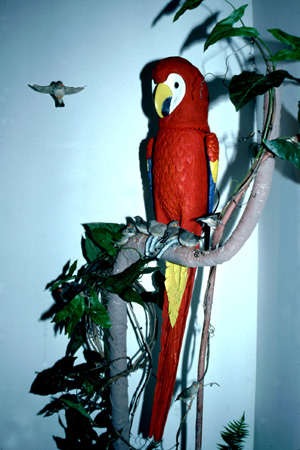
Rara Avis, a networked telepresence installation by Eduardo Kac (1996)
Ken Goldberg
"We must rediscover a commerce with the world and a presence to the
world that is older than intelligence." Merleau-Ponty (1945)
I'm interested in the distance between the viewer and what is being
viewed. How does technology alter our perceptions of distance, scale,
and structure? Technologies for viewing continue to evolve, from the
camera obscura to the telescope to the atomic force microscope; each
new technology raises questions about what is real versus what is an
artifact of the viewing process. I've become increasingly interested
in the epistemological question: "How do I know this is real?" The
visitor acts and perceives this "reality" throught an instrument with
no objective scale. How does the framed vision of the microscope
differ from the framing induced by the World Wide Web? Discontinuities
induced by these media can undermine what Husserl calls the "inner"
and "outer" horizons of experience. These horizons are vital to
architecture and to what we might call "telepistemology": how distance
influences belief, truth, and perception.
Ken Goldberg is an artist and engineer on the faculty at UC Berkeley.
He has exhibited technology based artwork internationally including
exhibitions at New Langton Arts '97, Ars Electronica '96, Dutch
Electronic Art Festival '96, and LAX '92. His installations have won
juried awards at the Interactive Media Festival, the Festival for
Interactive Arts, New Voices/New Visions, and the National Information
Infrastructure Awards. He was named an NSF Presidential Faculty
Fellow in 1995.
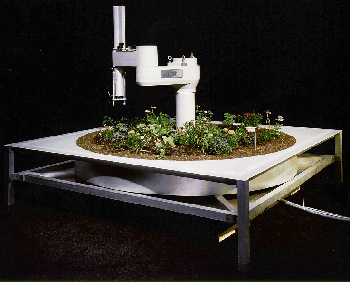
The Telegarden: An Interactive Installation on the WWW. (Ken Goldberg
1995) (Photo by Robert Wedermeyer)
Mark Pauline
Survival Research Laboratories (SRL) was conceived of and founded by
Mark Pauline in November 1978. Since its inception, SRL has operated
as an organization of creative technicians dedicated to re-directing
the techniques, tools, and tenets of industry, science, and the
military away from their typical manifestations in practicality,
product or warfare. Since 1979, SRL has staged over 50 mechanized
presentations in the United States and Europe. Each performance
consists of a unique set of ritualized interactions between machines,
robots, and special effects devices, employed in developing themes of
socio-political satire. Humans are present only as audience or
operators.
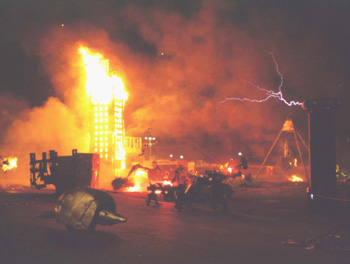
The Unexpected Destruction of Elaborately Engineered Artifacts: A
Misguided Adventure in Risk Eradication, Happening Without Known
Cause, in Connection with Events that are Not Necessarily Related (SRL
/ Austin, Texas / March 1997) (Photo by Alan Anzalone)
Eric Paulos
Eric Paulos is a Graduate Student in the Computer Science Department
at the University of California, Berkeley. His research interests
revolve around robotics and WWW based telepresence, particually human
centered robotics. He has developed several WWW based tele-operated
robots including, Mechanical Gaze (1995), Space Browsers (1996), and
Surface Cruisers (1997). With Mark Pauline, Judith Donath, and John
Canny, he designed and implemented Legal Tender (1996), a WWW
tele-robotic system that allows users to examine a pair of $100 bills
and experiment on them to determine their authenticity. His work has
has been exhibited internationally, including SIGGRAPH, the Dutch
Electronic Art Festival (DEAF) in Rotterdam, the Blasthaus Gallery,
and a performance for the opening of the Whitney Museum of American
Art's 1997 Biennial Exhibition.
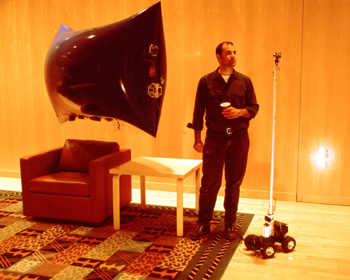
Tele-Embodiment: Space Browser and Surface Cruiser (Paulos 1997)
Stelarc
Stelarc is a performance artist who is interested in alternate
aesthetic strategies. He has used medical, robot and virtual reality
systems to explore, extend and enhance the body's performance
parameters. In the past he has acoustically and visually probed the
body - amplifying his brainwaves, heartbeat, bloodflow and muscle
signals and filming the inside of his lungs, stomach and colon.
Having experimented with the limitations of the body, he has developed
strategies to augment its capabilities, interfacing the body with
prosthetics and computer technologies. For the fifth Australian
Sculpture Triennale in 1993 he inserted an electronic object into his
stomach cavity and tracked its operation with video
endoscopy. Recently he has developed a touch-screen interfaced muscle
stimulation system that enabled the remote actuation of the body. The
Ping Body software stimualtes the body to move to the ebb and flow of
internet activity. He has performed extensively overseas with his
Third Hand, Virtual Arm, Virtual Body and industrial robot arms in art
events, including new music, dance festivals and experimental
theatre. Stelarc's artwork is solely represented by the Sherman
Galleries in Sydney. Between 1995-1997 he received an Australia
Council Arts/Craft Board Fellowship.
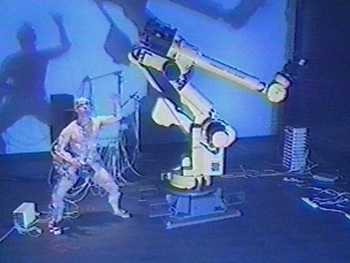
Host Body / Coupled Gestures (Stelarc)
Contact Information
John Canny
Professor
University of California, Berkeley
jfc@cs.berkeley.edu
http://www.cs.berkeley.edu/~jfc
Ken Goldberg
Assistant Professor
Industrial Engineering and Operations Research Department
University of California at Berkeley
goldberg@ieor.berkeley.edu
http://www.ieor.berkeley.edu/~goldberg
Eduardo Kac
Assistant Professor of Art and Technology
The School of the Art Institute of Chicago
ekac@artic.edu
http://www.uky.edu/FineArts/Art/kac/kachome.html
Mark Pauline
Founder/Director
Survival Research Laboratories
markp@srl.org
http://www.srl.org
Eric Paulos
Computer Science Graduate Student
University of California at Berkeley
paulos@cs.berkeley.edu
http://www.cs.berkeley.edu/~paulos/
Stelarc
Performance Artist
Research into muscle stimulation and remote actuation of the body
stelarc@peg.apc.org
http://www.merlin.com.au/stelarc/
References
Ballard, J. G. Crash, Noonday Press, 1973.
Benjamin, W. Art in the Age of Mechanical Reproduction, 1939.
Legal Tender
http://www.counterfeit.org
Goertz, R. and Thompson, R. "Electronically controlled manipulator," Nucleonics, 1954.
Goldberg, K., Mascha, M., Gentner, S., Rothenberg, N., Sutter, C., and Wiegley, J. "Robot Teleoperation Via the WWW," International Conference on Robotics and Automation, 1995.
Kac, Edwardo. "Interactive Art on the Internet", Wired World, Proceedings of the Ars Electronica Symposium, Peter Weibel, 1995.
Paulos, E. and Canny, J. "Ubiquitous Tele-embodiment: Applications and
Implications", Special Issue on Innovative Applications of the World
Wide Web, International Journal of Human-Computer Studies, 1997.
Ping Body
http://www.merlin.com.au/stelarc/pingbody/
PRoP: Personal Roving Presence
http://vive.cs.berkeley.edu/prop
Rara Avis
http://www.uky.edu/FineArts/Art/kac/raraavis.html
Survival Research Laboratories
http://www.srl.org
The Telegarden
http://telegarden.aec.at
Copyright:
You may view documents and images contained within this WWW page.
However, you may not copy for profit or publication any of these
documents and/or images without prior written permission from the
artist involved. If you
actually find something you would like to use, please contact Eric Paulos who will
direct you to the proper person for permission.





